Add this eBook to your basket to receive access to all 382 records. Our indexes include entries for the spelling dwyer. In the period you have requested, we have the following 382 records (displaying 291 to 300): These sample scans are from the original record. You will get scans of the full pages or articles where the surname you searched for has been found. Your web browser may prevent the sample windows from opening; in this case please change your browser settings to allow pop-up windows from this site.  Outstanding soldiers of the 17th (The Duke of Cambridge's Own) Lancers
(1881-1901) Outstanding soldiers of the 17th (The Duke of Cambridge's Own) Lancers
(1881-1901)
Each year the best soldiers of the regiment were chosen for long service and good conduct medals. This register gives rank, name, regimental number, and date of recommendation. (The sample scan is from the East Surrey regiment). The register is essentially a register of recommendations, annotated with details of the issue of the medals. Where no gratuity accompanied the medal, the entry is marked 'W. G.' (without gratuity); where, for one reason or another, the medal was not issued, the entry is marked 'N. S.' (not sanctioned) and struck through. The regiment embarked for Natal 25 February 1879, taking part in the Zulu war of 1879, adding "South Africa, 1879" to the colours, and were transferred to India late in the year. By 1885 the troops were based at Lucknow. One squadron was sent to Egypt (returning to England 2 November 1891) but the bulk of the regiment came home 3 November 1890. In 1895 the 17th Lancers were based at Leeds; in 1897 they were sent to Ireland; and in 1900 to South Africa, where they gained the honour "South Africa, 1900-1902". | Sample scan, click to enlarge
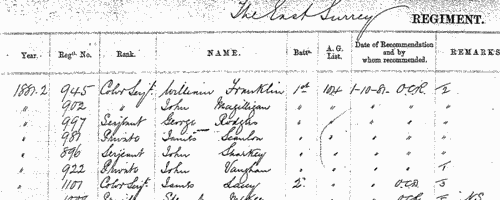
|  Outstanding soldiers of the Alexandra, Princess of Wales's Own (Yorkshire Regiment)
(1881-1901) Outstanding soldiers of the Alexandra, Princess of Wales's Own (Yorkshire Regiment)
(1881-1901)
Each year the best soldiers of the regiment were chosen for long service and good conduct medals. This register gives rank, name, regimental number, and date of recommendation. (The sample scan is from the East Surrey regiment). The register is essentially a register of recommendations, annotated with details of the issue of the medals. Where no gratuity accompanied the medal, the entry is marked 'W. G.' (without gratuity); where, for one reason or another, the medal was not issued, the entry is marked 'N. S.' (not sanctioned) and struck through. The regiment was based on the 19th Regimental District - Richmond in Yorkshire. The 1st battalion embarked for Egypt 3 August 1884, and took part in the action of Giniss; in 1888 the battalion was moved to Cyprus, and in 1889 back to England; to Jersey in 1892; to Ireland in 1895; to Gibraltar in 1898; back to England in 1899. That year the battalion was sent off to the war in South Africa, taking part in the relief of Kimberley, and the fighting at Paardeberg, Driefontein, Johannesburg, Diamond Hill and Belfast, returning to England in September 1902 - having added "South Africa, 1899-1902", "Relief of Kimberley" and "Paardeberg" to the regimental honours. The 2nd battalion returned to England from India 21 January 1877, moved to Ireland in 1881, and in 1885 was stationed at the Curragh; having returned to England in 1886, the battalion embarked for India 1 January 1890, and by 1895 was serving at Shwebo in Burmah, having taken part in the North West Frontier campaign. | Sample scan, click to enlarge
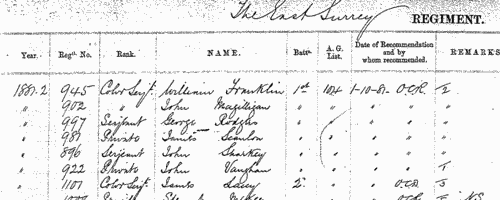
|  Outstanding soldiers of the British Army Commissariat and Transport Department
(1881-1901) Outstanding soldiers of the British Army Commissariat and Transport Department
(1881-1901)
Each year the best soldiers of the department were chosen for long service and good conduct medals. This register gives rank, name, regimental number, and date of recommendation. (The sample scan is from the East Surrey regiment). The register is essentially a register of recommendations, annotated with details of the issue of the medals. Where no gratuity accompanied the medal, the entry is marked 'W. G.' (without gratuity); where, for one reason or another, the medal was not issued, the entry is marked 'N. S.' (not sanctioned) and struck through. | Sample scan, click to enlarge
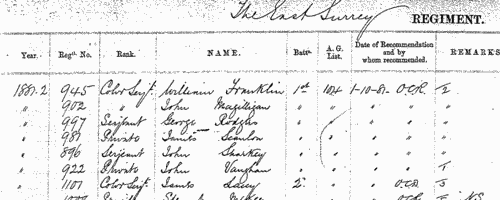
|  Outstanding soldiers of the Duke of Cambridge's Own (Middlesex Regiment)
(1881-1901) Outstanding soldiers of the Duke of Cambridge's Own (Middlesex Regiment)
(1881-1901)
Each year the best soldiers of the regiment were chosen for long service and good conduct medals. This register gives rank, name, regimental number, and date of recommendation. (The sample scan is from the East Surrey regiment). The register is essentially a register of recommendations, annotated with details of the issue of the medals. Where no gratuity accompanied the medal, the entry is marked 'W. G.' (without gratuity); where, for one reason or another, the medal was not issued, the entry is marked 'N. S.' (not sanctioned) and struck through. The regiment was based on the 57th Regimental District - Hounslow. The 1st battalion returned from Zululand to Ireland in October 1879; was moved to the Channel Islands in 1882, and back to England in 1884 and in 1885 was stationed at Dover. The battalion was sent back to Ireland in 1888, and from there to Gibraltar in 1892. It returned from Gibraltar to England 1 March 1895, and was based at Aldershot. In 1896 it was sent out to South Africa, and in 1898 on to India. The 2nd battalion embarked for Bengal in 1880, and by 1885 was serving at Secunderabad, and by 1895 was at Ahmednugger. The battalion returned to England in 1898, and was then sent out in 1899 to South Africa, where it added "South Africa, 1900" and "Relief of Ladysmith" to the regimental honours. | Sample scan, click to enlarge
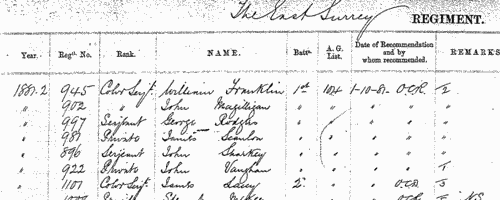
|  Outstanding soldiers of the Duke of Cornwall's Light Infantry
(1881-1901) Outstanding soldiers of the Duke of Cornwall's Light Infantry
(1881-1901)
Each year the best soldiers of the regiment were chosen for long service and good conduct medals. This register gives rank, name, regimental number, and date of recommendation. (The sample scan is from the East Surrey regiment). The register is essentially a register of recommendations, annotated with details of the issue of the medals. Where no gratuity accompanied the medal, the entry is marked 'W. G.' (without gratuity); where, for one reason or another, the medal was not issued, the entry is marked 'N. S.' (not sanctioned) and struck through. The regiment was based on Regimental District No. 32 - Bodmin. The 1st battalion returned from the Cape of Good Hope in September 1877, and in 1885 was stationed at Dublin; it embarked for Malta late that year, and went on to India, being at Meerut by 1895. The 2nd battalion embarked for Bermuda 21 October 1876, was sent to Gibraltar in 1880, and to Egypt in 1882, adding "Egypt, 1882", "Tel-el-Kebir" and "Nile, 1884-1885" to the regimental honours. The battalion returned to England in 1886; was sent to Ireland in 1891; back to England in 1898; and off to South Africa in 1899, where it gained the honours "South Africa, 1899-1902" and "Paardeberg". | Sample scan, click to enlarge
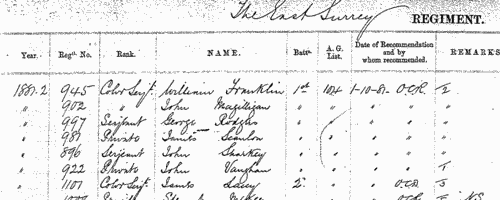
|  Outstanding soldiers of the Prince of Wales' Own (West Yorkshire Regiment)
(1881-1901) Outstanding soldiers of the Prince of Wales' Own (West Yorkshire Regiment)
(1881-1901)
Each year the best soldiers of the regiment were chosen for long service and good conduct medals. This register gives rank, name, regimental number, and date of recommendation. (The sample scan is from the East Surrey regiment). The register is essentially a register of recommendations, annotated with details of the issue of the medals. Where no gratuity accompanied the medal, the entry is marked 'W. G.' (without gratuity); where, for one reason or another, the medal was not issued, the entry is marked 'N. S.' (not sanctioned) and struck through. The regiment was based on the 14th Regimental District - York. The 1st battalion returned from India in 1879, was transferred to Ireland in 1883, and in 1885 was at Galway. In 1891 the battalion returned to England, embarking for Gibraltar 8 January 1895. In 1896 it moved on to Hong Kong, and in 1897 to India. The 2nd battalion embarked for Bengal in 1878, and in 1885 was at Sealkote. It was transferred to Aden in 1894, and from there to Cape Coast Castle in 1895, returning to England the following year. The troops were sent out to South Africa in 1899, adding "South Africa, 1899-1902" and "Relief of Ladysmith" to the regimental honours. | Sample scan, click to enlarge
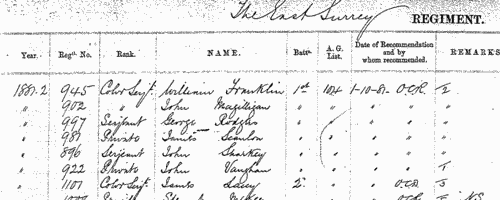
|  Outstanding soldiers of the Royal Irish Rifles
(1881-1901) Outstanding soldiers of the Royal Irish Rifles
(1881-1901)
Each year the best soldiers of the regiment were chosen for long service and good conduct medals. This register gives rank, name, regimental number, and date of recommendation. (The sample scan is from the East Surrey regiment). The register is essentially a register of recommendations, annotated with details of the issue of the medals. Where no gratuity accompanied the medal, the entry is marked 'W. G.' (without gratuity); where, for one reason or another, the medal was not issued, the entry is marked 'N. S.' (not sanctioned) and struck through. The regiment was based on the 83rd Regimental District - Belfast. The 1st battalion returned to England from South Africa in 1882, and was stationed on Guernsey by 1885. Having served in Ireland 1887 to 1894, in 1895 it was at Brighton. In 1897 the battalion was sent to South Africa, and in 1898 on to India. The 2nd battalion embarked for Bermuda in 1880, and moved to Halifax, Nova Scotia, in 1883; in 1886 to Gibraltar, in 1887 on to Egypt; in 1891 to Malta; and in 1894 to India. In 1895 we find the battalion at Bombay; but in 1899 it was transferred to South Africa, where it added "South Africa, 1899-1902" to the regimental honours. | Sample scan, click to enlarge
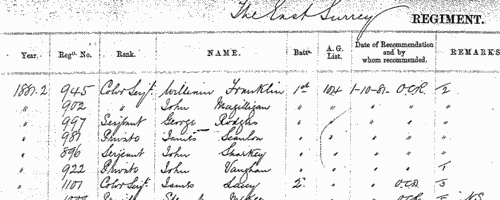
| Unclaimed Naval Prize Money
(1855-1902)
Various prize moneys were awarded to officers and men who served on board her Majesty's ships. For one reason or another a substantial number of these prizes, from as little as a shilling or two to as much as many pounds, remained undistributed by 1902, when this comprehensive list of the unclaimed moneys was printed: it lists unclaimed shares of prize money, slave and pirate bounties, salvage awards, parliamentary grants, gratuities and other moneys distributed by the Admiralty 1855 to 1902, but which omits moneys for service on the China Station during the war of 1856 to 1880, and special gratuities for service in Egypt (1882), Soudan (1884) and Soudan and Nile Expedition (1884-1885), for which there are separate indexes. In each case the sailor's name is given first (surname, then christian name or initials); rank or rating; ship in which serving at time of capture or award; and the amount due. | Sample scan, click to enlarge

|  British artillerymen fighting in South Africa
(1899-1902) British artillerymen fighting in South Africa
(1899-1902)
The Queen Victoria's South Africa Medal was awarded (after her death, in the event) to all who had served honourably in the various campaigns in the Boer War. Returns were made from each unit, and consolidated into nominal roll, of which this is the one for the Royal Artillery. Confusingly, the ledgers used had originally been printed for a register of men transferred (or re-transferred after mobilization) to 1st Class Army Reserve. All the original column headings were therefore struck through, and the roll was prepared with this information: Date of Issue; Regimental Number; Rank; Name; Unit; Medal (a 1 indicating that a medal was awarded); [number of] Clasps; the reference to the source in the original returns, usually starting with AG for papers in the hands of the Adjutant-General, and 68/Art/ for the Royal Artillery records. The final column, normally left blank, was occasionally used for explanatory remarks. | Sample scan, click to enlarge

| Associate Members of the Institution of Civil Engineers
(1904)
The Institution of Civil Engineers was established 2 January 1818, and incorporated by royal charter 3 June 1828. The annual report lists the names and addresses (throughout the world) of the four classes of member - members (M. Inst. C. E.), associate members (Assoc. M. Inst. C. E.), associates (Assoc. Inst. C. E.), students (Stud. Inst. C. E.) - with the dates of admission. This is the index to the Associate Members. The symbols at the left of each page are * for Former Students, + for contributors of papers published in the Minutes of Proceedings, or of an Engineering Conference Note; F for a deliverer of a James Forrest Lecture; L for a deliverer of one of the Special Series of Lectures; and various letters for recipients of certain medals and prizes - B, Bayliss Prize; C, Crampton Prize; f, James Forrest Medal; H, Howard Quinquennial Prize; J, Joule Medal; M, Miller Scholarship; m, Miller Prize; italic m, Manby Premium; S, George Stephenson Medal or Prize; T, Telford Premium; t, Telford Premium; italic t, Trevithick Premium; and W, Watt Medal. Those elected prior to 2 December 1878 had been transferred into this class by the Council. | Sample scan, click to enlarge
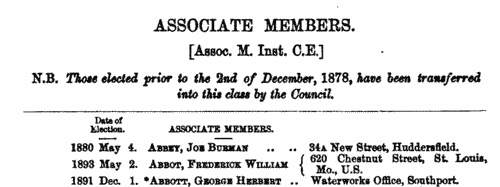
|
Research your ancestry, family history, genealogy and one-name study by direct access to original records and archives indexed by surname.
|












